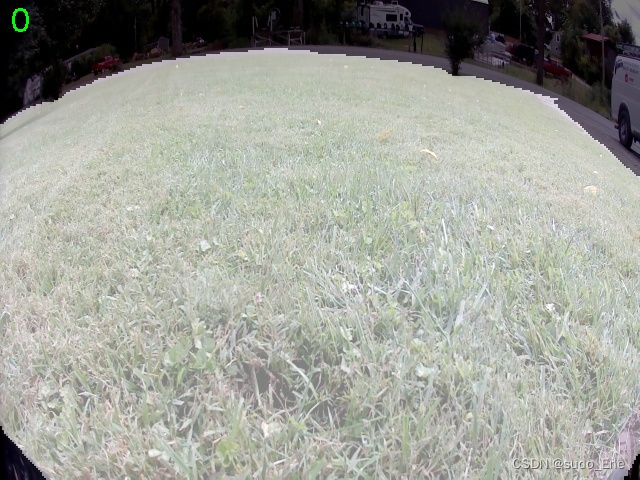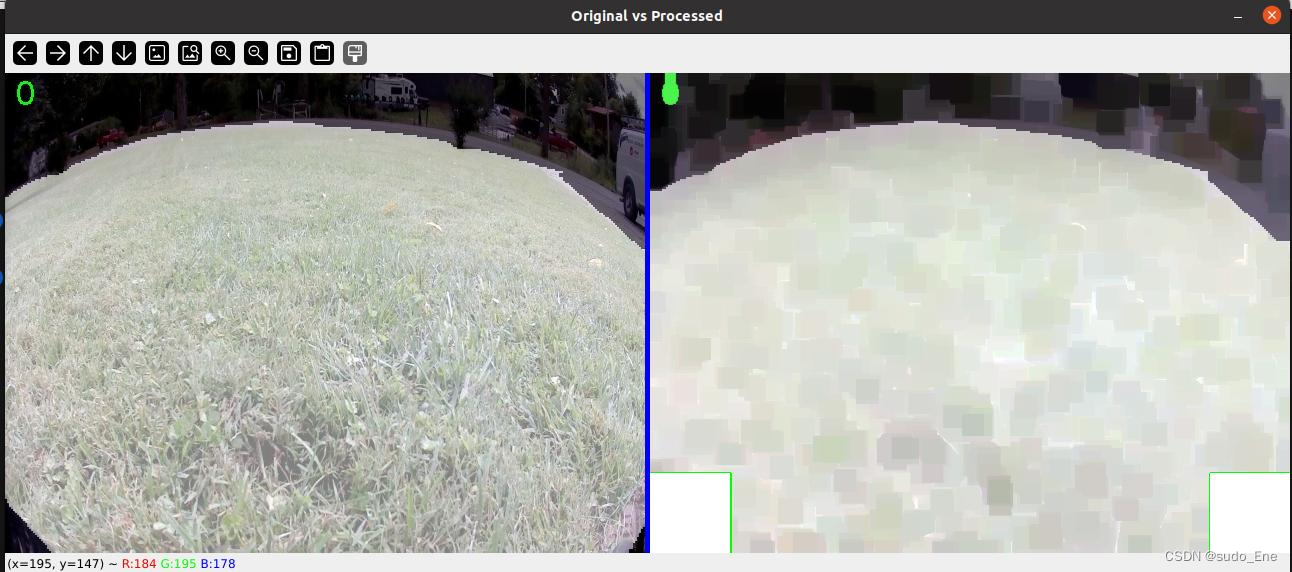在使用智能工具标注时,经常会出现边缘部分没有标注上mask区域的情况。会对训练的准确度造成一定程度的影响。
将mask.PN图片进行膨胀和腐蚀操作后,边角部分的mask区域没有完全补齐,因此再划定两个roi区域,通过比较mask占比来填充。
下图为将原图和mask区域重合后的图片,可以看到左右两角有黑色区域。(因为没有png的问题图片,用jpg的图片先试试看效果)

import cv2
import numpy as np
import os
# 定义膨胀和腐蚀的核
kernel = np.ones((3, 3), np.uint8)
# PNG格式原始图像路径
image_path = '/home/lxy/Desktop/test/fushi_imgae_test/mask'
# 读取PNG格式的原始图像
images = []
for file in os.listdir(image_path):
if not file.endswith(".png"):
# if not file.endswith(".jpg"):
continue
image_file = os.path.join(image_path, file)
if not os.path.exists(image_file):
continue
image = cv2.imread(image_file)
images.append(image)
# 对原始图像进行膨胀和腐蚀操作
processed_images = []
for image in images:
dilated_image = cv2.dilate(image, kernel, iterations=10)
eroded_dilated_image = cv2.erode(dilated_image, kernel, iterations=10)
processed_images.append(eroded_dilated_image)
# 定义ROI区域的坐标
roi1_tl = (0, 400) # 区域一左上角坐标
roi1_br = (80, 480) # 区域一右下角坐标
roi2_tl = (560, 400) # 区域二左上角坐标
roi2_br = (640, 480) # 区域二右下角坐标
# 在图像上绘制两个ROI区域
for i in range(len(images)):
processed_images[i] = cv2.rectangle(processed_images[i], roi1_tl, roi1_br, (0, 255, 0), 2)
processed_images[i] = cv2.rectangle(processed_images[i], roi2_tl, roi2_br, (0, 255, 0), 2)
# 计算mask区域所占比例,并将整个ROI区域划为mask
for i in range(len(images)):
# 提取ROI区域
roi1 = processed_images[i][roi1_tl[1]:roi1_br[1], roi1_tl[0]:roi1_br[0]]
roi2 = processed_images[i][roi2_tl[1]:roi2_br[1], roi2_tl[0]:roi2_br[0]]
# 计算ROI区域的总像素数量
total_pixels_roi1 = roi1.shape[0] * roi1.shape[1]
total_pixels_roi2 = roi2.shape[0] * roi2.shape[1]
# 计算mask区域的像素数量
mask_pixels_roi1 = np.count_nonzero(roi1)
mask_pixels_roi2 = np.count_nonzero(roi2)
# 计算mask区域所占比例,避免除以零错误
mask_ratio_roi1 = mask_pixels_roi1 / total_pixels_roi1 if total_pixels_roi1 != 0 else 0
mask_ratio_roi2 = mask_pixels_roi2 / total_pixels_roi2 if total_pixels_roi2 != 0 else 0
# 如果mask区域所占比例超过70%,则将整个ROI区域划为mask
if mask_ratio_roi1 > 0.7:
processed_images[i][roi1_tl[1]:roi1_br[1], roi1_tl[0]:roi1_br[0]] = 255
if mask_ratio_roi2 > 0.7:
processed_images[i][roi2_tl[1]:roi2_br[1], roi2_tl[0]:roi2_br[0]] = 255
# 创建一个蓝色的间隔框
blue_line = np.zeros((processed_images[0].shape[0], 5, 3), dtype=np.uint8)
blue_line[:] = (255, 0, 0) # 蓝色
# 显示原始图像和处理后的图像
current_index = 0
while True:
combined_image = np.hstack((images[current_index], blue_line, processed_images[current_index]))
cv2.imshow('Original vs Processed', combined_image)
key = cv2.waitKey(0) & 0xFF
if key == ord('a'):
current_index = (current_index - 1) % len(images)
elif key == ord('d'):
current_index = (current_index + 1) % len(images)
elif key == 27: # ESC键
break
# 关闭所有窗口
cv2.destroyAllWindows()
结果:

得到的图片为png格式或jpg格式,如有需要json格式还需要再进行转换。
附:
根据labelme.json文件和jpg文件来进行腐蚀和膨胀操作。
import cv2
import numpy as np
import os
import json
from tqdm import tqdm
from PIL import Image, ImageDraw, ImagePath
# 读取原始图像
jpg = '/home/lxy/Desktop/test/fushi_imgae_test/jpg/'
labelme_json = '/home/lxy/Desktop/test/fushi_imgae_test/labelme_json/'
# 遍历 LabelMe 格式的 JSON 文件夹中的所有文件,只处理 JSON 格式的文件
for file in tqdm(os.listdir(labelme_json)):
if not file.endswith(".json"):
continue
# 根据 JSON 文件名生成对应的图像文件名,并检查该图像文件是否存在。
image_name = file.replace(".json", ".jpg")
image_file = os.path.join(jpg, image_name)
if not os.path.exists(image_file):
continue
# 读取图像文件
image = cv2.imread(image_file)
cv2.imshow('image_file',image)
# cv2.waitKey(6000)
# cv2.destroyAllWindows(27)
mask_img = np.zeros_like(image)
with open(os.path.join(labelme_json, file), 'r') as f:
data = f.read()
# convert str to json objs
data = json.loads(data)
# 遍历 JSON 文件中的标注信息,获取标签和边界点
for idx,d in enumerate(data['shapes']):
label = d['label']
points = d['points']
path = tuple(map(tuple, points))
# 将边界点连接起来并填充为白色,以创建标注掩码图像
mask_img = cv2.drawContours(mask_img, [np.array(points)], 0, (255, 255, 255), -1)
kernel = np.ones((3, 3), np.uint8) # 定义膨胀的核大小
# 对标注掩码图像进行腐蚀操作
eroded_mask_img = cv2.erode(mask_img, kernel, iterations=10)
# kernel = np.ones((5, 5), np.uint8) # 定义腐蚀的核大小
# 对标注掩码图像进行膨胀操作
dilated_mask_img = cv2.dilate(mask_img, kernel, iterations=10)
# result = mask_img - eroded_mask_img
# 先膨胀再腐蚀
dilated_mask_img = cv2.dilate(mask_img, kernel, iterations=15)
eroded_dilated_mask_img = cv2.erode(dilated_mask_img, kernel, iterations=10)
# 计算腐蚀后的区域大小
gray_img = cv2.cvtColor(eroded_mask_img, cv2.COLOR_BGR2GRAY)
_, binary_img = cv2.threshold(gray_img, 1, 255, cv2.THRESH_BINARY)
contours, _ = cv2.findContours(binary_img, cv2.RETR_EXTERNAL, cv2.CHAIN_APPROX_NONE)
area = cv2.contourArea(contours[0])
# 如果区域大小达到 1000,则保留;否则涂黑
if area >= 1800:
# 保留标签区域
final_img = eroded_mask_img
border_points = [tuple(point[0]) for point in contours[0]]
# 输出边界坐标点列表
# print(border_points)
# 修改标签区域以外的像素的 RGB 值
for i in range(image.shape[0]):
for j in range(image.shape[1]):
if eroded_mask_img[i, j, 0] != 255:
# 修改标签区域以外的像素的 RGB 值为你想要的颜色
image[i, j] = [0, 0, 0] # 将像素修改为全黑色
# 保存结果图像
cv2.imwrite(jpg+'/'+str(idx)+'mask_img.jpg',mask_img)
cv2.imwrite(jpg+'/'+str(idx)+'_dilated.jpg', dilated_mask_img)
cv2.imwrite(jpg+'/'+str(idx)+'_eroded.jpg',eroded_mask_img)
# 保存经过先膨胀再腐蚀处理的图像
cv2.imwrite(jpg+'/'+str(idx)+'_eroded_dilated.jpg', eroded_dilated_mask_img)2024.3.25新增:
import cv2
import numpy as np
import os
import json
from tqdm import tqdm
'''
读取 LabelMe 格式的 JSON 文件,并根据标注信息创建标注掩码图像
对标注掩码图像进行膨胀和腐蚀操作
划定两块roi区域
在这两块roi区域中 分别求取mask区域所占比例 如果超过70% 则将整个roi区域划为mask
'''
# 读取 LabelMe 格式的 JSON 文件夹和保存标注掩码图像的文件夹
labelme_json_dir = '/home/lxy/Desktop/test/fushi_imgae_test/labelme_json'
mask_output_dir = '/home/lxy/Desktop/test/fushi_imgae_test/mask'
# 定义膨胀和腐蚀的核
kernel = np.ones((3, 3), np.uint8)
# 遍历 LabelMe 格式的 JSON 文件夹中的所有文件,只处理 JSON 格式的文件
for file in os.listdir(labelme_json_dir):
if not file.endswith(".json"):
continue
# 读取 JSON 文件
with open(os.path.join(labelme_json_dir, file), 'r') as f:
data = json.load(f)
# 创建与图像相同大小的空白图像作为标注掩码图像
mask_img = np.zeros((data['imageHeight'], data['imageWidth']), dtype=np.uint8)
# 根据 JSON 文件中的标注信息创建标注掩码图像
for shape in data['shapes']:
points = np.array(shape['points'], np.int32)
cv2.fillPoly(mask_img, [points], 255)
# 对标注掩码图像进行膨胀和腐蚀操作
dilated_mask_img = cv2.dilate(mask_img, kernel, iterations=1)
eroded_dilated_mask_img = cv2.erode(dilated_mask_img, kernel, iterations=1)
# 定义两块 ROI 区域
roi1_tl = (0, 400) # 区域一左上角坐标
roi1_br = (80, 480) # 区域一右下角坐标
roi2_tl = (560, 400) # 区域二左上角坐标
roi2_br = (640, 480) # 区域二右下角坐标
# 计算两块 ROI 区域中 mask 区域所占比例,并根据条件将整个 ROI 区域划为 mask
mask_ratio_roi1 = np.count_nonzero(eroded_dilated_mask_img[roi1_tl[1]:roi1_br[1], roi1_tl[0]:roi1_br[0]]) / ((roi1_br[1] - roi1_tl[1]) * (roi1_br[0] - roi1_tl[0]))
mask_ratio_roi2 = np.count_nonzero(eroded_dilated_mask_img[roi2_tl[1]:roi2_br[1], roi2_tl[0]:roi2_br[0]]) / ((roi2_br[1] - roi2_tl[1]) * (roi2_br[0] - roi2_tl[0]))
if mask_ratio_roi1 > 0.7:
eroded_dilated_mask_img[roi1_tl[1]:roi1_br[1], roi1_tl[0]:roi1_br[0]] = 255
if mask_ratio_roi2 > 0.7:
eroded_dilated_mask_img[roi2_tl[1]:roi2_br[1], roi2_tl[0]:roi2_br[0]] = 255
# 保存处理后的标注掩码图像
mask_output_path = os.path.join(mask_output_dir, file.replace('.json', '_mask.png'))
cv2.imwrite(mask_output_path, eroded_dilated_mask_img)
对新的掩码图像(labelme.png)转回json文件(labelme.json)
import cv2
import numpy as np
import os
import json
# 读取膨胀和腐蚀后的标注掩码图像的文件夹和保存恢复的 LabelMe JSON 文件的文件夹
mask_output_dir = '/home/lxy/Desktop/test/fushi_imgae_test/mask'
restored_json_dir = '/home/lxy/Desktop/test/fushi_imgae_test/picture'
# 遍历膨胀和腐蚀后的标注掩码图像的文件夹中的所有文件
for file in os.listdir(mask_output_dir):
if not file.endswith("_mask.png"):
continue
# 读取标注掩码图像
mask_img = cv2.imread(os.path.join(mask_output_dir, file), cv2.IMREAD_GRAYSCALE)
# 创建一个空的 LabelMe 格式 JSON 数据
labelme_data = {
"version": "5.0.1",
"flags": {},
"shapes": [],
"imagePath": file.replace('_mask.png', '.png'),
"imageData": None,
"imageHeight": mask_img.shape[0],
"imageWidth": mask_img.shape[1]
}
# 根据标注掩码图像恢复标注信息
contours, _ = cv2.findContours(mask_img, cv2.RETR_EXTERNAL, cv2.CHAIN_APPROX_SIMPLE)
for contour in contours:
shape = {
"label": "0",
"points": contour.reshape(-1, 2).tolist(),
"group_id": None,
"shape_type": "polygon",
"flags": {}
}
labelme_data["shapes"].append(shape)
# 保存恢复的 LabelMe JSON 文件
restored_json_path = os.path.join(restored_json_dir, file.replace('_mask.png', '_restored.json'))
with open(restored_json_path, 'w') as f:
json.dump(labelme_data, f, indent=4)






















 742
742











 被折叠的 条评论
为什么被折叠?
被折叠的 条评论
为什么被折叠?








